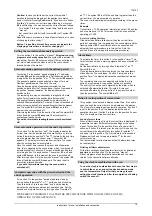
179732
Instructions for use, installation and connection
8
(deep tray) for moist cake, for roasting or for intercepting
dripping oil/grease.
Telescopic slide guides
(certain models only)
Note
! Telescopic slide guides and other oven accessories
might get very hot! Use kitchen gloves or other suitable
protection!
The oven is fitted with telescopic guides on the left and right
side in three levels. Pull out slide supports on guides may be
fully or partially retracted.
•
To insert the grid, baking or roasting pan, first slide out the
telescopic guides for one particular level.
•
Place the tray or pan on the guides and push them back
completely into the oven.
Close the oven door only after you have pushed the telescopic
guides into the oven.
Grease filter
(depending on the model).
Inserted grease filter at the rear panel of the oven protects the
fan, the heater and the oven from accidental staining with
grease. For roasting meat we recommend the use of grease.
Remove the filter when baking pastry. Grease filter might
cause unsuccessful baking of some kinds of pastry.
Baking pastry
Most appropriate position for baking is the application of both
upper and lower heater, or the hot air.
Note
!
Grease filter must always be removed!
Warnings
•
When baking pastry, strictly follow the instructions regarding
the selection of guide level, temperature and baking time,
and do not rely on any previous experience, because
information indicated in the baking tables have been
determined and tested specially for this particular type of
oven.
•
In case you may not find any particular type of cake in the
tables, use the information available for the next most similar
type of cake.
Baking with upper and lower heater
•
Use only a single guide level.
•
This baking position is especially suitable for baking dry
pastry, bread and teacakes.Use dark baking pans. Light
pans reflect heat and pastry is not adequately browned.
•
Always place baking pans on the grid rack. Remove the grid
only if baking in the flat biscuit tray, supplied with the
appliance.
•
Preheating shortens the baking time. Do not put the cake in
the oven until proper temperature is obtained, and until the
red signal lamp goes off for the first time.
Baking with hot air
•
This mode of baking is especially suitable for baking at
multiple levels, for moist pastry and fruit cakes.
•
You may use light models.
•
The temperature is usually lower than baking with
upper/lower heater (see Baking Table).
•
Moist pastry (i.e. fruit cake) may be baked at maximum two
levels at the same time, because of excessive humidity.
•
Different cakes may be baked together if the necessary
temperature is approximately the same.
•
Baking time may be different for different pastry, so you may
have to take one pan out before the others.
•
Cookies, like for example muffins, should be of equal size
and thickness. Uneven cookies are baked unevenly.
•
If you bake more than one cake at the same time, it may
produce excessive steaming in the oven and condensation
at the oven door.
Baking tips
Is pastry baked?
Pierce the cake with a wooden peg at the thickest part. If the
dough does not stick to it, the cake is baked. You may switch
off the oven and use the remaining heat.
Pastry has fallen
Check the recipe. Use less fluids next time. Follow the mixing
times, especially when using powered kitchen mixers.
Pastry is too light below
Use dark baking pan next time, or place the pan one level
lower, or switch on the lower heater a while before the
completion.
Cheese cake is undercooked
Next time reduce the baking temperature and extend the
baking time.
Warnings regarding the baking tables:
•
The tables indicate the temperature range. Always select
lower temperature first. You may always increase the
temperature in case pastry needs more baking.
•
Baking times
are indicative only. They may vary in
dependence of individual characteristics.
•
The asterix indicates that the oven requires preheating.




































